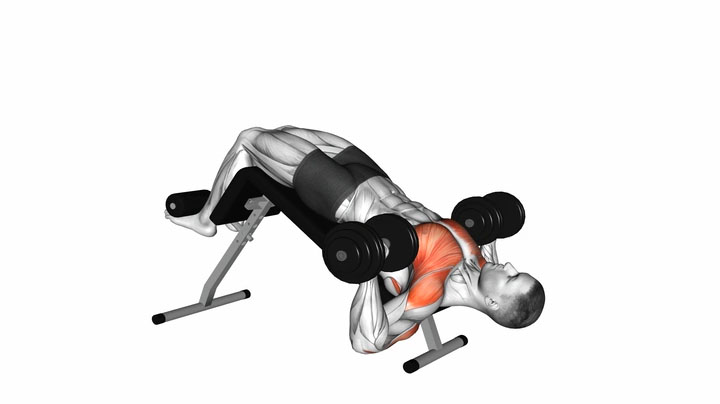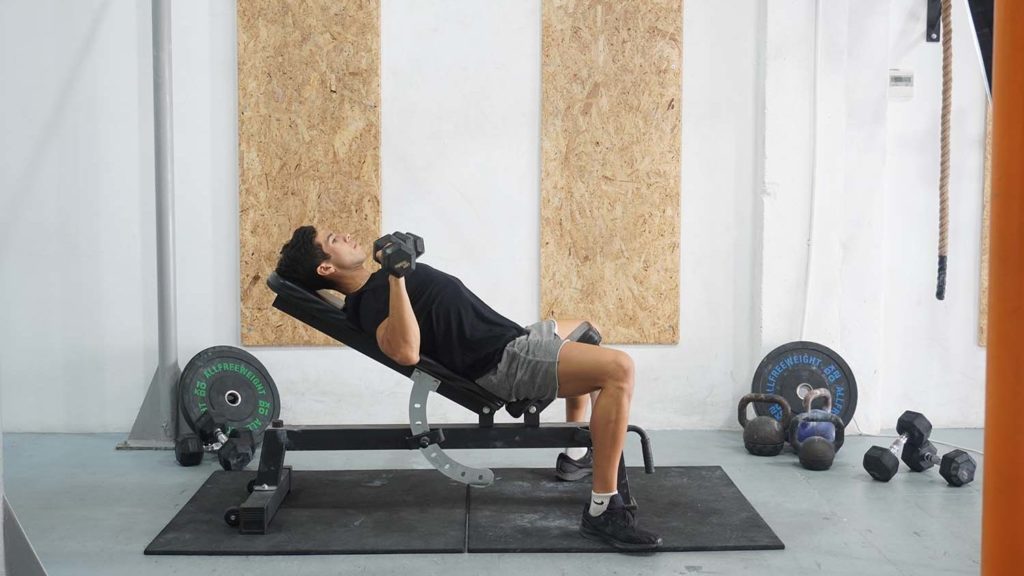Why is the dumbbell bench press a beneficial exercise?
The dumbbell bench press is a simple and accessible chest exercise that builds muscle mass and strength. Using dumbbells is beneficial because they provide instability, which forces you to work hard for your balance.
Having weight in each hand also forces both sides of your body to work independently, reducing the risk of muscle or strength imbalances. Plus, similar to the barbell bench press, using dumbbells offers a fantastic overloading potential. You can increase the load as you get stronger for a long time.
Thanks to the more significant stability requirements, the dumbbell bench press forces our core muscles to engage more, leading to greater stability.
Another overlooked benefit of the dumbbell bench press is that it works well for folks who experience joint pain when using a barbell. Dumbbells allow you to move more freely and adjust the movement pattern, so you can bypass aches and train safely.
How to do a Dumbbell Bench Press
- Set an adjustable gym bench into a flat position.
- Grab a pair of dumbbells, sit on the gym bench, and place both weights on top of your thighs.
- Bring your shoulders back, engage your abs, take a breath, and flex your arms.
- Kick both dumbbells up with your thighs as you lie back. Doing so will allow you to get in position on the bench and position the dumbbells over your chest.
- With your arms straight and dumbbells over your chest, dig your shoulder blades into the bench and place your feet flat on the floor.
- Take another breath and lower both dumbbells to your sides. Keep your elbows somewhat tucked; avoid flaring them to your sides.
- Lower the weights until your elbows are at torso level, and hold the bottom position for a second.
- Press both dumbbells to the starting position, bringing them together and straightening your arms. Exhale near the top.
- Take another breath and repeat.
What muscles does the bench press (dumbbell) activate?
The primary muscles that work during a dumbbell bench press are the pectorals (chest), which cover the front side of the upper torso.
Our pectoralis major consists of the sternal and clavicular heads, which insert into the humerus (upper arm bone) (1). The clavicular head originates from the clavicle and the sternal portion from the sternum. The muscle group assists with arm adduction (bringing it in from the side), extension, and more.
Bench pressing dumbbells also trains our shoulders, mainly the anterior head, which assists the chest in arm extension (2). The whole deltoid muscle flexes isometrically to keep the shoulder joint stable throughout the movement.
Our triceps are the third major muscle group involved in the bench press (2). The muscle covers the rear of our upper arms and produces elbow extension, an essential part of the bench press (3). Our chest is more active from the bottom position, but our triceps contribute more as we straighten our arms.
Our midsection (abs, transverse abdominis, and obliques), upper back (trapezius, lats, and rhomboids), and glutes also assist during a dumbbell bench press. All of these muscles flex isometrically and provide stability during the exercise.
Tips for Proper Form and Technique
The most important tip to keep in mind for the dumbbell bench press is to set up correctly. Meaning, you have to follow the rules from above to lie back on the bench and have the dumbbells over your chest. Doing so puts you in a solid and stable position for safe and heavy pressing.
Another vital tip to keep in mind is to use a full range of motion unless you’re experiencing any sort of shoulder discomfort. The goal is to lower the weight until your elbows are at the torso level. You then have to press the dumbbells until your arms are straight. Doing so allows you to stretch and contract your pectorals effectively, leading to superior growth.
The third important thing to remember is to have your elbows somewhat close to your torso. Doing so will keep you in a stable position and protect your shoulders. Flaring your elbows weakens your position and increases the risk of shoulder impingement.
Variations and Modifications of the Dumbbell Bench Press
1. Single-Arm Dumbbell Bench Press
The single-arm version is a challenging alternative to the traditional dumbbell press. You have to hold onto a single weight, making it more difficult to remain stable. Plus, single-arm pressing is a great way to focus on one side at a time and perfect your technique.
2. Dumbbell Floor Press
The dumbbell floor press is a valuable variation that limits your range of motion and keeps your shoulders in a healthy position. Additionally, the floor press is good because it stops you from taking advantage of the stretch reflex, forcing your chest and triceps to work extra hard in pressing the weight.
3. Dumbbell Squeeze Press
The squeeze press is a variation where you hold onto a pair of dumbbells with a neutral grip and press them against one another. Doing so improves chest activation because you’re extending your arms and squeezing your hands together.
Mistakes to Avoid
One of the most common and dangerous mistakes with the dumbbell press relates to your initial setup. Many trainees make the mistake of lying on the bench and raising the dumbbells off the floor. Doing so is dangerous because it puts your shoulders in a position for an injury.
Plus, setting up that way is much more difficult and becomes nearly impossible once you start using heavier dumbbells. Instead, hold onto the dumbbells, support them on your thighs, and lift them as you lie back on the bench.
The second significant mistake to avoid is using too much weight. Many eager trainees look to build strength fast, so they pick the heaviest dumbbells. The issue is that using too much weight compromises your technique, leads to compensatory movement patterns, and cuts your range of motion short.
Aside from increasing your risk of injury, each repetition becomes less effective. So, always pick the appropriate weights that allow you to do at least eight solid repetitions with a full range of motion.
Similar Exercises to the Dumbbell Bench Press
Decline Bench Press (Dumbbell)

Having your torso at a decline allows you to emphasize the middle and lower portions of your chest (4). Beyond that, the decline dumbbell bench press is similar to the flat variation in many ways.
Incline Bench Press (Dumbbell)

In contrast to the decline press, the incline dumbbell press is a variation that works your upper chest (clavicular head) (4). Having your torso at an incline puts your upper chest at a mechanical advantage, allowing it to do more of the work.
Bench Press (Barbell)

The flat barbell press is a fantastic alternative to the dumbbell version. The range of motion is excellent; you can overload the movement as you get stronger and develop the same muscle groups.



